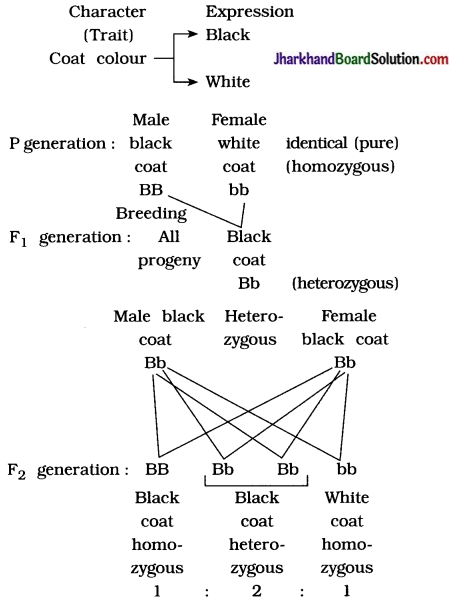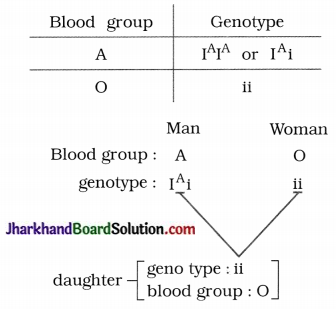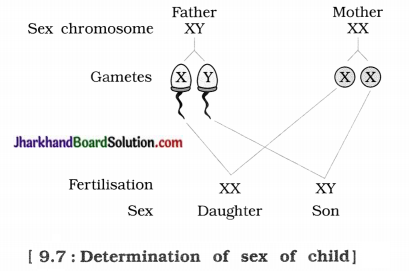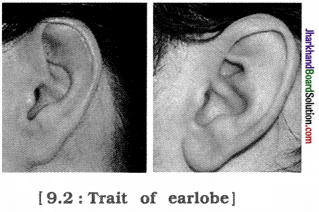Jharkhand Board JAC Class 10 Science Solutions Chapter 9 Heredity and Evolution Textbook Exercise Questions and Answers.
JAC Board Class 10 Science Solutions Chapter 9 Heredity and Evolution
Jharkhand Board Class 10 Science Heredity and Evolution Textbook Questions and Answers
Question 1.
A Mendelian experiment consisted of breeding tall pea plants bearing violet flowers with short pea plants bearing white flowers. The progeny all bore violet flowers, but almost half of them were short. This suggests that the genetic make-up of the tall parent can be depicted as …………..
A. TTWW
B. TTww
C. TtWW
D. TtWw
Answer:
A. TTWW
Question 2.
An example of homologous organs is …………..
A. our arm and a dog’s foreleg.
B. our teeth and an elephant’s tusks.
C. potato and runners of grass.
D. all of the above
Answer:
D. all of the above
Question 3.
In evolutionary terms, we have more in common with …………..
A. a Chinese school-boy.
B. a chimpanzee.
C. a spider.
D. a bacterium.
Answer:
A. a Chinese school-boy.
![]()
Question 4.
A study found that children with light coloured eyes are likely to have parents with light coloured eyes. On this basis, can we say anything about whether the light eye colour trait is dominant or recessive? Why or why not?
Answer:
No, we cannot say anything about whether the light eye colour trait is dominant or recessive on the basis of given information because information regarding cross between two traits, i.e., light colour with black eye colour is essential to determine it. In general population light coloured eyes are in much less proportion as compared to dark eyes. This indicates that it may be recessive trait.
Question 5.
How are the areas of study – evolution and classification – interlinked?
Answer:
One can work out the evolutionary relationships of the species by identifying hierarchies of characteristics between them.
Similarities among organisms will allow us to group them together. If the characteristics between two species are more common, then they are more closely related and they had a recent common ancestor.
Thus, build up small group of species with recent common ancestors, then super group with more distant common ancestors and so on. By this one can interlink the study of evolution and classification.
Question 6.
Explain the terms analogous and homologous organs with examples.
Answer:
Analogous organs : Organs with different structure and components but have common function.
Examples: The wing of a bat and the wing of a bird.
Homologous organs : Organs with similar basic structure but modified to perform different functions.
Examples : Fore limbs of frog, lizard, bird and human.
Question 7.
Outline a project which aims to find the dominant coat colour in dogs.
Answer:

So, black coat is dominant trait in dog. [If in F1 generation all progeny are with white coat then white coat can be considered as dominat trait.]
Question 8.
Explain the importance of fossils in deciding evolutionary relationships.
Answer:
Fossils are the remains or impressions of the dead animals and plants that lived in the past. Fossils are the direct evidence of evolution. If the fossils are found closer to the surface then they are more recent than the fossils found in deeper layers. One can find evolutionary relationships between ancient and present organisms by study of fossils. We also come to know the time period of evolutionary process by studying fossils.
Question 9.
What evidence do we have for the origin of life from inanimate matter?
Answer:
Stanley L. Miller and Harold C. Urey:
In 1953, they assembled an experiment in which primitive atmosphere was simulated. It had compounds like ammonia, methane, hydrogen and water vapour but no oxygen. This was maintained at a temperature just below 100°C and electric sparks were passed through the mixture of gases to simulate lightning. At the end of a week, 15% of the carbon had been converted to simple compounds of carbon including amino acids which are monomers of protein molecules.

Question 10.
Explain how sexual reproduction gives rise to more visible variations than asexual reproduction. How does this affect the evolution of those organisms that reproduce sexually?
Answer:
(1) Sexual reproduction gives rise to more visible variations than asexual reproduction because in sexual reproduction, each new generation is the combination of the DNA copies from two pre-existing individuals.
(2) Even during gamete formation new combination of genes occurs during meiosis. From more visible variations during sexual reproduction, certain favourable variation can be selected by natural selection.
Whereas in asexual reproduction generally offsprings are exact copies of their single parent.
![]()
Question 11.
How is equal genetic contribution of male and female parents ensured in the progeny?
Answer:
Male and female parents produce male gametes (Sperms) and egg cells (Ovum) respectively through a process of meiosis. It reduces the number of chromosomes and amount of DNA to half in gametes.
Such germ cells from two individuals, i. e., male and female parents are fused to form zygote. This ensures the equal genetic contribution of male and female parents in the progeny that develop from zygote.
Question 12.
Only variations that confer an advantage to an individual organism will survive in a population. Do you agree with this statement? Why or why not?
Answer:
Yes, because of useful inherited / genetic variations of an individual organism can adapt and survive. Moreover they leave behind more offsprings and populations with such genetic variations will survive.
Jharkhand Board Class 10 Science Heredity and Evolution InText Questions and Answers
Question 1.
If a trait A exists in 10 % of a population of an asexually reproducing species and a trait B exists in 60 % of the same population, which trait is likely to have arisen earlier?
Answer:
A trait B which exist in 60 % of population of an asexually reproducing species, must have arisen earlier than trait A.
Because in asexually reproducing species there are chances of appearance of very few new traits due to small inaccurancies during DNA copying. So, populations having trait A have arisen later.
Question 2.
How does the creation of variations in a species promote survival?
Answer:
The creation of variations in a species is either due to inaccuracies in DNA copying or during sexual reproduction.
- Depending on the nature of variations, different individuals have different kinds of advantages.
- The individuals with useful variations can adapt to the prevailing environment and show better survival.
- The individuals with useful variations then increase in numbers.
Question 3.
How do Mendel’s experiments show that traits may be dominant or recessive?
Answer:
Mendel’s conducted, cross fertilisation between pure tall plant (TT) and pure short plant (tt) which resulted in all tall (Tt) plant in F1 generation.
This shows that single copy of T is enough to make the plant tall. It shows that one trait which is expressed in the presence of its contrasting form. This is dominant trait and the other remains unexpressed in the presence of its contrasting form is recessive trait.
Question 4.
How do Mendel’s experiments show that traits are inherited independently?
Answer:
Mendel performed dihybrid experiment on pea plants. A tall plant with round seeds was crossed with a short plant with wrinkled seeds. Fx progeny plants were all tall with round seeds. F1 progeny are used to generate F2 progeny by self-pollination. Along with parental combinations, F2 progeny showed new combinations too. Some of them were tall with wrinkled seeds while some others were short with round seeds.
It means factors (genes) controlling for seed shape and height of plant recombine to form new combinations in F2 offsprings. Thus, tall/short trait and the round seed / wrinkled seeds trait are inherited independently.
Question 5.
A man with blood group A marries a woman with blood group O and their daughter has blood group O. Is this information enough to tell you which of the traits blood group A or O is dominant? Why or why not?
Answer:
No, the given information is not enough to tell us whether the trait of blood group A or blood group O is dominant.
- Blood group trait is controlled by genes and inherited from parents.
- Daughter has blood group O and two copies of genes as it inherited one each from the father and the mother.
For Information:
Trait blood group A is dominant and blood group O is recessive. This fact derived from the study of genotype.
Gene IA for blood group trait A
Gene i recessive for blood group trait O.

Question 6.
How is the sex of the child determined in human beings?
Answer:
The sex of the child will be determined in human beings by the sex chromosome inherited from father. Father has XY sex chromosomes in each of his cell. Two types of gametes (sperms) are produced based on chromosomes, 50 % sperms are with X chromosome and 50 % sperms are with Y chromosome.
When sperm bearing X chromosome fertilise the egg, girl is born and when sperm bearing Y chromosome fertilise the egg, son is born.

Question 7.
What are the different ways in which individuals with a particular trait may increase in a population?
Answer:
A particular trait may increase in a population by following ways:
- Natural selection – directing evolution with a survival advantage.
- Genetic drift – provides diversity without any adaptations.
![]()
Question 8.
Why are traits acquired during the life-time of an individual not inherited?
Answer:
Traits acquired during the life-time of an individual may not be inherited because they may be changes in non-reproductive tissues which cannot be passed on to the DNA of the germ cells and hence cannot be passed on its progeny.
Question 9.
Why are the small numbers of surviving tigers a cause of worry from the point of view of genetics?
Answer:
The small numbers of surviving tigers is a cause of worry from the point of view of genetics because if they become extinct then the genes of this species will be lost forever. There will be no chance of getting this species back again to life in future.
Question 10.
What factors could lead to the rise of a new species?
Answer:
Factors that can lead to the rise of a new species are –
- Gene flow
- Genetic drift
- Natural selection and
- Reproductive isolation.
Question 11.
Will geographical isolation be a major factor in the speciation of a self-pollinating plant species? Why or why not?
Answer:
No, geographical isolation will not be a major factor in the speciation of a self-pollinating plant species because single parent is involved in it. There is no gene flow between two geographically isolated population.
Question 12.
Will geographical isolation be a major factor in the speciation of an organism that reproduce asexually? Why or why not?
Answer:
No, geographical isolation will not be a major factor to the speciation that reproduces asexually because single parent is involved in asexual reproduction due to which variations are not formed.
Question 13.
Give an example of characteristics S being used to determine how close two species? are in evolutionary terms.
Answer:
Homologous organs are the characteristics < being used to determine two species are close in evolutionary terms.
Example: The basic structure of the limbs of mammals, birds, reptiles and amphibians is similar though it has been modified to perform different functions.
Question 14.
Can the wing of a butterfly and the wing of a bat be considered homologous organs? Why or why not?
Answer:
No. they are not considered homologous organs because the wing of a butterfly and the wing of a bat are similar in function but the designs of two wings, their structure and components are very different. So, they can be considered as analogous organs and not homologous.
Question 15.
What are fossils? What do they tell us about the process of evolution?
Answer:
Fossils are the remains or impressions of the dead animals and plants that lived in the past.
Fossils are the direct evidence of evolution. If the fossils are found closer to the surface then they are more recent than the fossils found in deeper layers. One can find evolutionary relationships between ancient and present organisms by study of fossils.
We also come to know the time period of evolutionary process by studying fossils.
Question 16.
Why are human beings who look so different from each other in terms of size, colour and looks said to belong to the same species?
Answer:
All human beings look so different from each other in size, colour and looks due to environmental factors, new combination of genes during reproduction.
All they belong to Homo sapiens and have descended from a common ancestor in Africa. They have capacity of interbreeding which is an important criteria to categorize them as one species.
Question 17.
In evolutionary terms, can we say which among bacteria, spiders, fish and chimpanzees have a better body design? Why or why not?
Answer:
In evolutionary terms, we can say that chimpanzees have a better developed body design among remaining three because chimpanzees are highly complex as compared to remaining three.
Activity 9.1 [T. B. Pg. 143]
To suggest rule for inheritance of earlobe type.
Procedure / Method:
- The lowest part of the ear pinna called the earlobe, is closely attached to the side of the head, i.e., attached or not, i.e., free.
- Observe the earlobes of all the students In – the class. Prepare a list of students. Enter < the data about the earlobes whether they are free or attached.
- Find out about the earlobes of the parents of each student in the class.
- Correlate earlobe type of each student with that of their parents.
- In the column write F for free earlobe and A for attached earlobe.

| No. | Details | Free Earlobe | Attached Earlobe |
| 1. | Name of student…. | ||
| Mother | |||
| Father | |||
| 2. | Name of student…. | ||
| Mother | |||
| Father |
Answer the following questions on the basis of the collected data:
Questions :
Question 1.
Which expression of earlobe is observed more in number in your class?
Answer:
Expression of free earlobe is observed more in number in our class.
Question 2.
Are the types of earlobes hereditary?
Answer:
Yes, the type of earlobe is hereditary.
![]()
Question 3.
From your collected data state which expression is dominant and which one is recessive for earlobe.
Answer:
Free earlobe is dominant and attached earlobe is recessive expression.
Question 4.
Determine the percentage of free earlobe and attached earlobe in the students of your classroom.
Answer:
There are 60 students in the classroom. Out of which 51 students have free earlobe and 9 students have attached earlobe.
Percentage of free earlobe = \(\frac { 51 }{ 60 }\) x 100 = 85 %
Percentage of attached earlobe = \(\frac { 9 }{ 60 }\) x 100
= 15 %
Activity 9.2 [T. B. Pg. 144]
What experiment would we do to confirm that F2 generation did infact have a 1:2:1 ratio of TT, Tt and tt trait combination?
We do Mendel’s monohybrid cross-experiment:
